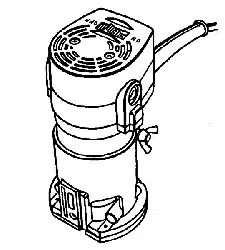Loading ...
Loading ...
Loading ...

FORCE FEEDING
Clean, smooth laminate trimming and edge shaping can be
done only when the cutter is revolving at a relatively high
speed and is taking very small bites to produce tiny, cleanly
severed chips. Ifyour trimmer isfomed to move forward too
fast, the speed of the cutter becomes slower than normal in
relationto itsforward movement. As a result, thecutter must
take bigger bites as it revolves. "Bigger bites" mean bigger
chips, and a rougher finish• Bigger chips also require more
power, which could result in the trimmer motor becoming
ovedoaded.
Under extreme force-feeding conditions the relative speed
of the cutter can become so stow -- and the bites it has to
take solarge-- that chips willbe partially knocked off (rather
than fully cut off), with resulting splintering and gougingofthe
workpiece. See Figure 5.
Your trimmer is an extremely high-speed tool (23,000 RPM
no-load speed), and willmake clean, smooth cuts ifallowed
to runfreely without the ovedoad of a forced (too fast) feed•
Three things that cause "force feeding" are cutter size, depth
ofcut, and workpiece characteristics. The larger the cutteror
the deeper the cut, the more slowly the trimmer should be
moved forward. If the wood is very hard, knotty, gummy or
damp, the operation must be slowed still more.
You can always detect "force feeding" by the sound of the
motor. Its high-pitched whine willsound lower and stronger
as it loses speed. Also, the strain of holding the tool will be
noticeably increased.
TOO SLOW FEEDING
Itisalso possible tospoil a cutby moving thetrimmer forward
too slowly• When it is advanced into the work too slowly, a
revolving cutter does not dig into new wood fast enough to
take a bite; instead, it simply scrapes away sawdust-like
particles. Scraping produces heat, which can glaze, burn, or
marthe cut-- in extreme cases, can even overheat thecutter
soas to destroy itshardness. Dull cutters can also contribute
to scraping and burning.
In addition, it is more difficult to control a trimmer when the
cutter is scraping instead of cutting• With practically no load
on the motor the cutter will be revolving at close totop RPM,
and will have a much greater than normal tendency to
bounce offthe sides of the cut (especially, ifthe wood has a
pronounced grain with hard and soft areas). As a result, the
cut produced may have sides that are rippled instead of
straight.
"Too-slow feeding" can also cause yourtrimmer totake offin
a wrong direction from the intended line of cut. You can
detect "foo-slow feeding" by the high-pitched sound of the
motor. Always grasp and hold your trimmer firmly with
both hands when trimming.
DEPTH OF CUT
See Figure6.
As previously mentioned, the depth of cut is important
because itaffects the rate of feed which, in turn, affects the
Page
J
TO SLOW
TOFAST
DEPTH
OF CUT
Fig. ,=
,,.. WIDTH
OF CUT
2ND.
PASS
1ST.
PASS
IST'PAS_6
hn 2ND. PASS
quality of a cut (and, also, the possibilityof damage to your
trimmer motorand cutter), Adeep cut requires a slowerfeed
than a shallow one, and a too deep cut willcause you toslow
the feed so much that the cutter is no longer cutting, it is
scraping, instead.
Making a deep cut is never advisable. The smaller cutters--
especially those only 1/16 in. in diameter-- are easily broken
off when subjected to too much side thrust. A large enough
cutter may not be broken off, but ifthe cut is too deep a rough
cut will result -- and it may be very difficult to guide and
control the cutter as desired. For these reasons, we
recommend that you do not exceed 1/8 in. depth of cut in a
single pass, regardless of the cutter size or the softness or
condition of the workpiece. This will result in a higher quality
cut.
To make deeper cuts it is therefore necessary to make as
many successive passes as required, lowering the cutter
1/8 in. for each new pass. In order to save time, do all the
cutting necessary at one depth setting, before lowering
the cutter for the next pass. This will also assure a uniform
depth when the final pass is completed.
10
Loading ...
Loading ...
Loading ...
